Analysis of the Characteristics and Cause Analysis of Soil Salt Space Based on the Basin Scale
Abstract
:1. Introduction
2. Materials and Methods
2.1. Overview of the Study Area
2.2. Sample Collection and Test
2.3. Sample Processing and Analysis
2.4. Research Methods
- (1)
- Semi variogram
- (2)
- Estimation of reasonable sampling number
- (3)
- Anisotropic nesting
- (4)
- Model inspection
3. Results and Analysis
3.1. Basic Statistical Analysis of Soil Salt Content
3.2. Accuracy Analysis of Sampling Number
3.3. Spatial Variation Characteristics of Soil Salinity
3.3.1. Isotropic Analysis
3.3.2. Anisotropy Analysis
3.3.3. Nested Structure Analysis and Spatial Distribution Characteristics
4. Discussion
5. Conclusions
- (1)
- The average values of soil salinity in each layer of soil in the Weigan River Basin oasis were generally high. The soil of the layer between 0 m and 0.25 m was severely salinized, while the soil of the layers between 1 m and 2 m and between 2 m and 3 m were moderately salinized. The three layers of soil salinity did not conform to a normal distribution, and showed strong variability, with the coefficients of variation ranging from 1.15 to 1.26;
- (2)
- According to Cochran’s formula for calculating the reasonable random sampling size, at the 95% confidence level and 20% relative error, the sampling numbers of the three layers of soil were 89, 73, and 61, respectively. When calculating the reasonable number of samples, not only the accuracy of the sampling should be taken into account, but also the economy and efficiency of sampling should be considered under the premise of ensuring accuracy;
- (3)
- The spatial variation direction of soil salinity in each layer was evident, and the long-axis range corresponding to the maximum anisotropy ratio first decreased and then increased as the depth decreased. The spatial variation structure of soil salinity in the layer between 0 m and 0.25 m was fitted with a nested model, and then interpolated with Kriging, and it was found that soil salinity showed a gradually increasing trend from the center to the edge of the oasis;
- (4)
- The analysis of variation function shows that soil salinity in the layer between 0 m and 0.25 m shows a moderate spatial correlation, while soil salinity in the layers between 1 m and 2 m and between 2 m and 3 m show strong spatial correlations, in which topography and groundwater level were the main structural factors affecting soil spatial variability, and farming and irrigation were the main random factors. Therefore, it is proposed that the comprehensive effect of various factors should be considered in the treatment of salinization, especially natural factors such as the local terrain, soil structure, and groundwater level, to build an efficient irrigation system and a reliable drainage system, and to effectively control soil salinization and realize gradual desalination, thereby achieving the effect of comprehensive treatment of salinized soil and improving land use efficiency.
Author Contributions
Funding
Institutional Review Board Statement
Informed Consent Statement
Data Availability Statement
Conflicts of Interest
References
- Yang, Y.; Shi, X.; Yu, D.; Wang, H.; Xu, M.; Wang, G. Study on spatial variation of soil nutrients at regional scale and its influencing factors. Sci. Geogr. Sin. 2008, 28, 788–792. [Google Scholar]
- Zhao, R.; Chen, Y.; Hong, C.; Li, W.B. Spatial variation and pattern analysis of soil salt content in oasis of Tarim River Source Region-Taking Yuepu Lake oasis as an example. Geogr. Res. 2008, 1, 135–144. [Google Scholar]
- Yao, R.; Yang, J.; Liu, G. Study on spatial variability of groundwater characteristics of typical plots in the Yellow River Delta. Chin. Soil Sci. 2006, 6, 1071–1075. [Google Scholar]
- Li, L.; Yi, Y.; Ling, G.; Wang, S. Application of geostatistics in soil spatial variation research. Chin. Soil Sci. 2005, 2, 265–268. [Google Scholar]
- Li, H.; Wang, G.; Wang, Q. Theory and method of quantitative research on spatial heterogeneity. Chin. Appl. Ecol. 1998, 6, 93–99. [Google Scholar]
- Zhang, J.; Xu, W.; Yuan, D.; Zhang, X.; Wang, C. Spatial distribution characteristics of soil salinity in mirabilite mining area under humid monsoon climate. Mount. Sci. 2016, 34, 157–164. [Google Scholar]
- Emadi, B. Comparison of spatial interpolation techniques for mapping soil pH and salinity in agricultural coastal areas, northern Iran. Arch. Agron. Soil Sci. 2014, 60, 1315–1327. [Google Scholar] [CrossRef]
- Taghizadeh-Mehrjardi, R.; Sarmadian, F.; Minasny, B.; Triantafilis, J.; Omid, M. Digital Mapping of Soil Classes Using Decision Tree and Auxiliary Data in the Ardakan Region, Iran. Arid. Soil Res. Rehabil. 2014, 28, 147–168. [Google Scholar] [CrossRef]
- Douaik, A.; van Meirvenne, M.; Tóth, T. Soil salinity mapping using spatio-temporal kriging and Bayesian maximum entropy with interval soft data. Geoderma 2005, 128, 234–248. [Google Scholar] [CrossRef]
- Eljebri, S.; Mounir, M.; Faroukh, A.T.; Zouahri, A.; Tellal, R. Application of geostatistical methods for the spatial distribution of soils in the irrigated plain of Doukkala, Morocco. Model. Earth Syst. Environ. 2018, 5, 669–687. [Google Scholar] [CrossRef]
- Yu, S.; Liu, J.; Eneji, A.E.; Liu, H.; Han, L. Spatial Variability of Soil Salinity under Subsurface Drainage. Commun. Soil Sci. Plant Anal. 2015, 46, 259–270. [Google Scholar] [CrossRef]
- Benslama, A.; Khanchoul, K.; Benbrahim, F.; Boubehziz, S.; Chikhi, F.; Navarro-Pedreño, O. Monitoring the Variations of Soil Salinity in a Palm Grove in Southern Algeria. Sustainability 2020, 12, 6117. [Google Scholar] [CrossRef]
- Wang, D.; Yu, Z.; Cheng, M.; Zhao, C.; Ding, J.; Zhang, X. Analysis of soil salinity change characteristics of different land use types in Weigan River Oasis. Arid Land Geo. 2018, 41, 349–357. [Google Scholar]
- Zhao, Z.L.; Tiyip, T.; Sun, Q.; Lei, L.; Zhang, F. Analysis of soil spectral characteristics and extraction of salinization information —Taking Weigan River / Kuche river oasis in Xinjiang as an example. Prog. Geogr. 2014, 33, 280–288. [Google Scholar]
- Lian, G.; Guo, X.; Fu, B.; Hu, C. Spatial variation characteristics and prediction of soil nutrients in Small Watersheds on the Loess Plateau. Acta Ecol. Sin. 2008, 3, 946–954. [Google Scholar]
- Zhang, X.; Chen, Y.; Zhang, P.; Yang, F. Spatial distribution and variation characteristics of soil salinity in agricultural irrigation areas of the Peacock River Basin. Soils 2016, 48, 1223–1228. [Google Scholar]
- Li, Y.; Ding, J.; Mireguli, A. Analysis of salt distribution characteristics and driving factors in soil profile of Wei Ku oasis. Irrig Drain. 2019, 38, 58–65. [Google Scholar]
- Ding, J.; Zhang, F.; Jiang, H. Study on spatial variability of soil salinity and conductivity in oases in the northern margin of Tarim Basin-A case study of Weigan Kuqa River Delta Oasis. Arid. Zone Geogr. 2008, 31, 624–632. [Google Scholar]
- Lu, R. Soil Agrochemical Analysis Method; China Agricultural Science and Technology Press: Beijing, China, 1999. [Google Scholar]
- Chen, S.; Feng, Y.; Xu, Y. Preliminary study on Soil Nutrient Variation and reasonable sampling number. Xin Iang Agric. Sci. 2003, 6, 328–331. [Google Scholar]
- Liu, A. Introduction to Geostatistics; Science Press: Beijing, China, 2012. [Google Scholar]
- Dan, X. Spatial Variation and Three-Dimensional Simulation of Soil Organic Matter and Total Nitrogen in Different Scales of Farmland; Henan University of Technology: Henan, China, 2016. [Google Scholar]
- Huo, X.; Li, H.; Zhang, W.; Sun, D.; Zhou, L.; Li, B. Multi scale spatial structure of heavy metals in cultivated soils in Beijing. Trans. Chin. Soc. Agric. Eng. 2009, 25, 223–229. [Google Scholar]
- Xinjiang Department of Agriculture, Xinjiang Soil Survey Office. Xinjiang Soil; Science Press: Beijing, China, 1996; pp. 151–521. [Google Scholar]
- Wang, F.; Su, Y. Evaluation of spatial variability of soil properties in typical ecosystem location observation sample plots. Soil Water Conserv. 2007, 2, 95–98+118. [Google Scholar]
- Fan, Y.; Li, S.; Zheng, J.; Wang, Q.; Li, S. Spatial variability of grassland soil organic matter and determination of sampling number in Yunwu Mountain Nature Reserve of Ningxia. Pratac. Sci. 2007, 4, 8–13. [Google Scholar]
- Gao, T.T.; Ding, J.L.; Ha, X.P.; Zhang, F.; Wang, F. Spatial variation characteristics of soil salinity based on Watershed Scale–Taking the delta oasis of Weigan River Kuche River Basin as an example. Acta Ecol. Sin. 2010, 30, 2695–2705. [Google Scholar]
- Zhang, S.; He, Y.; Fang, H. Study on spatial variability of field soil characteristics based on GPS and GIS. J. Agric. Eng. 2003, 2, 39–44. [Google Scholar]
- Cambardella, C.A.; Moorman, T.B.; Novak, J.M.; Parkin, T.B.; Karlen, D.L.; Turco, R.F.; Konopka, A.E. Field-Scale Variability of Soil Properties in Central Iowa Soils. Trans. Chin. Soc. Agric. Eng. 1994, 58, 1501–1511. [Google Scholar] [CrossRef]
- Trangmar, B.B.; Yost, R.S.; Uehara, G. Application of geostatistics to spatial studies of soil properties. Adv. Agron. 1986, 38, 45–94. [Google Scholar]
- Chen, Y. Study on Spatial-Temporal Variation and Precise Zoning Management of Soil Nutrients in Oasis Farmland; Shihezi University: Shihezi, China, 2008. [Google Scholar]
- Zhang, F.; Liu, Z.; Qu, W.; Kang, Z.; Shen, Y. Spatial variability of soil organic matter in small-scale farmland under long-term cultivation. Agric. Res. Arid. Areas 2010, 28, 167–171. [Google Scholar]
- Hu, K.; Yu, Y.; Zhang, F.; Wang, R. Spatial and temporal variation of soil organic matter content in Beijing suburb and its influencing factors. Sci. Agric. Sin. 2006, 4, 764–771. [Google Scholar]
- Zhu, J.; Guo, S.; Yang, Y.; Li, P.; Zhang, Q.; Dai, Q.; Zhang, K. Spatial and temporal variation characteristics of soil salinity in green land of Tianjin Binhai Development Zone. Trans. Chin. Soc. Agric. Eng. 2016, 32 (Suppl. S2), 161–168. [Google Scholar]
- Kang, M.; Zhao, C.; Bai, X. Spatial heterogeneity and influencing factors of soil total salt content in Sugan Lake Wetland. Acta Ecol. Sin. 2021, 41, 2282–2291. [Google Scholar]
- Zhang, F.; Xiong, H.; Tian, Y.; Luan, F. Influence of regional scale topographic factors on spatial distribution of soil salinization in Qitai oasis. Res. Environ. Sci. 2011, 24, 731–739. [Google Scholar]
- Li, Y.; Zhang, F.; Pan, X.; Chen, F.; Lai, X. Cumulative change of soil salinity in different geomorphic types in Manas River Basin of Xinjiang. Trans. Chin. Soc. Agric. Eng. 2007, 2, 60–64. [Google Scholar]
- Maimaimaiti, Y.; Tursun, A.G.; Yusufu, A. Analysis of crop water demand in oasis of Weihe Kuhe Delta. Water Sav. Irrigation. 2015, 11, 85–88. [Google Scholar]
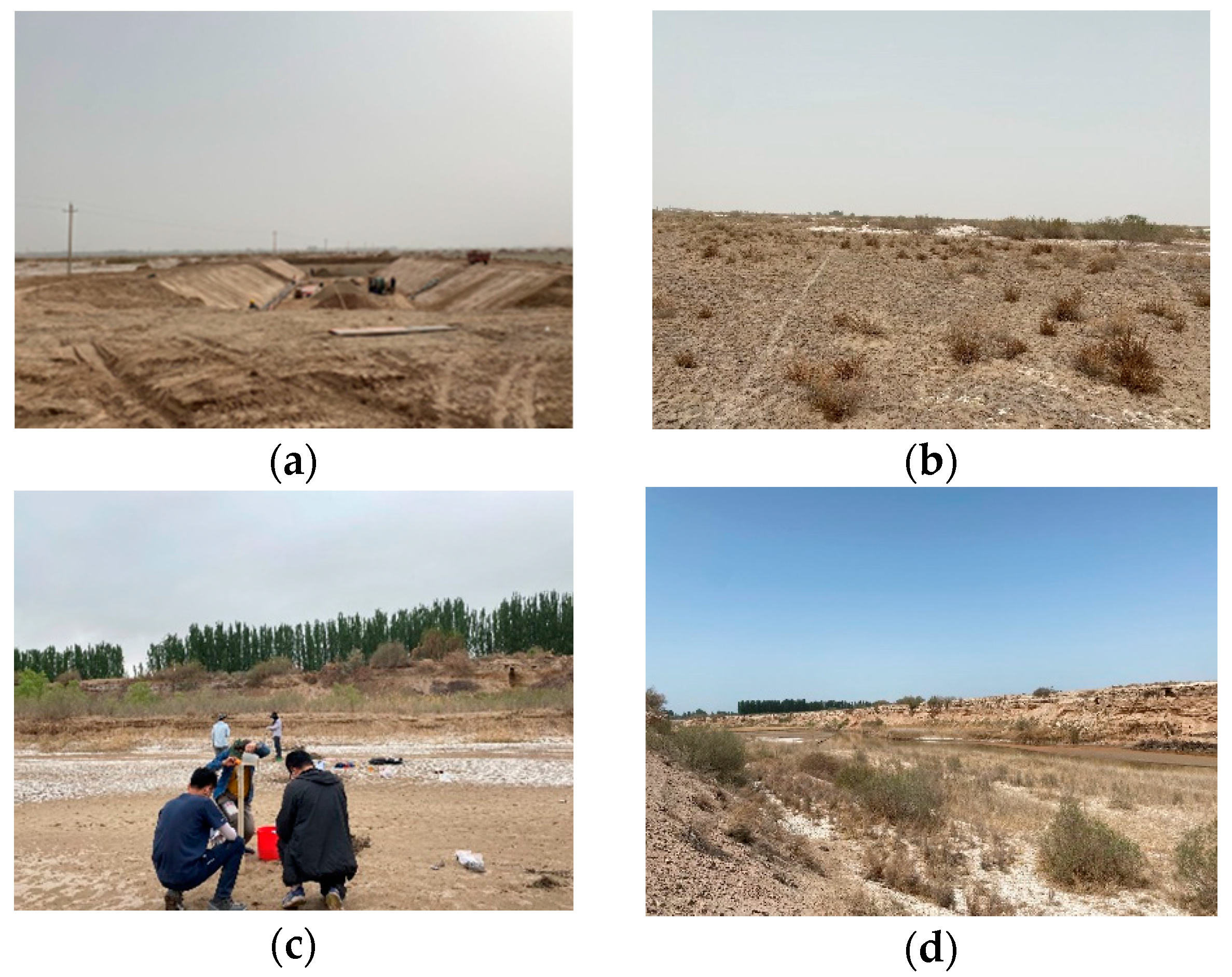
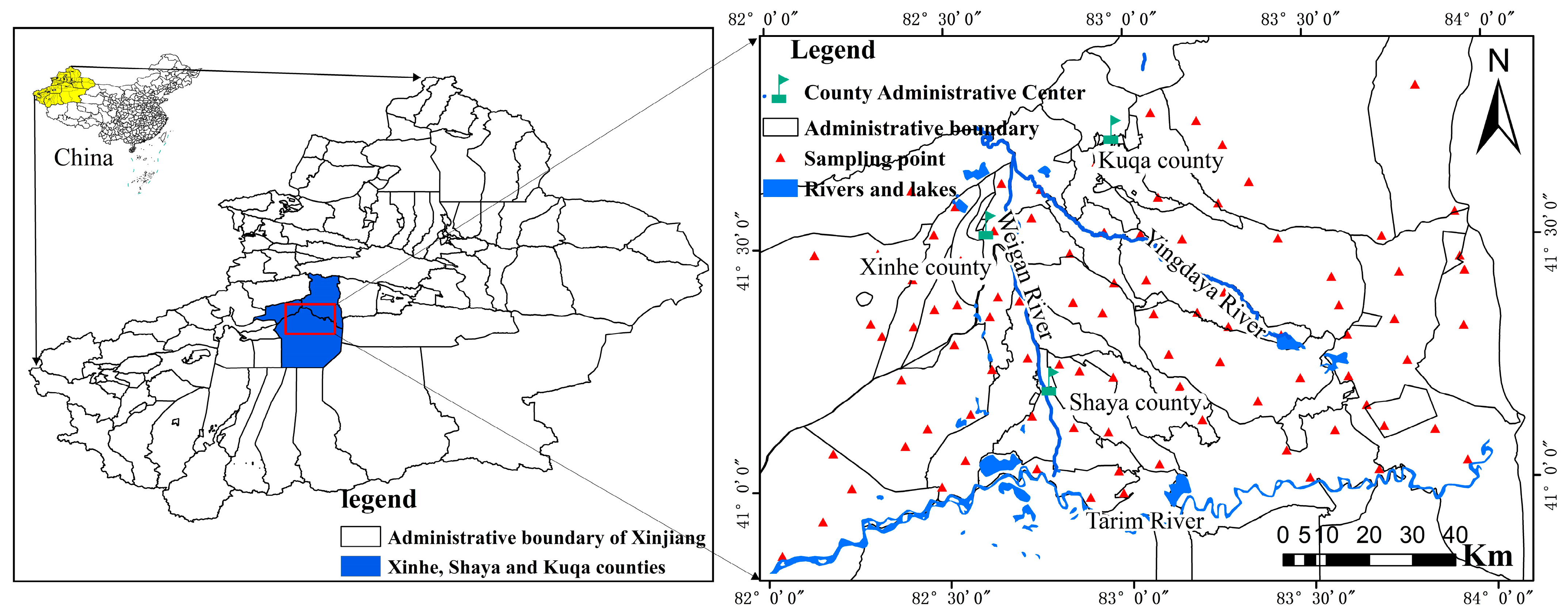
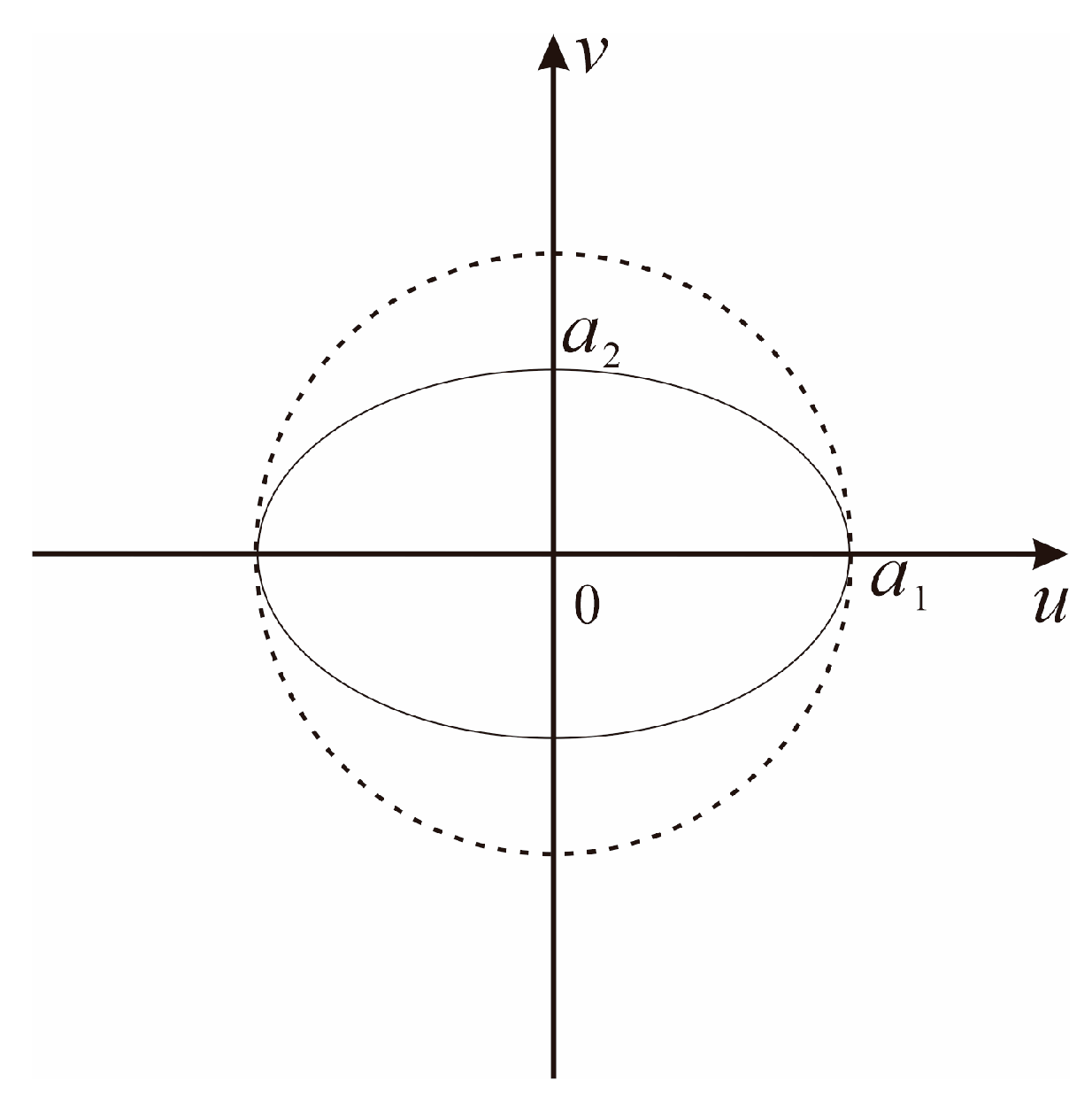





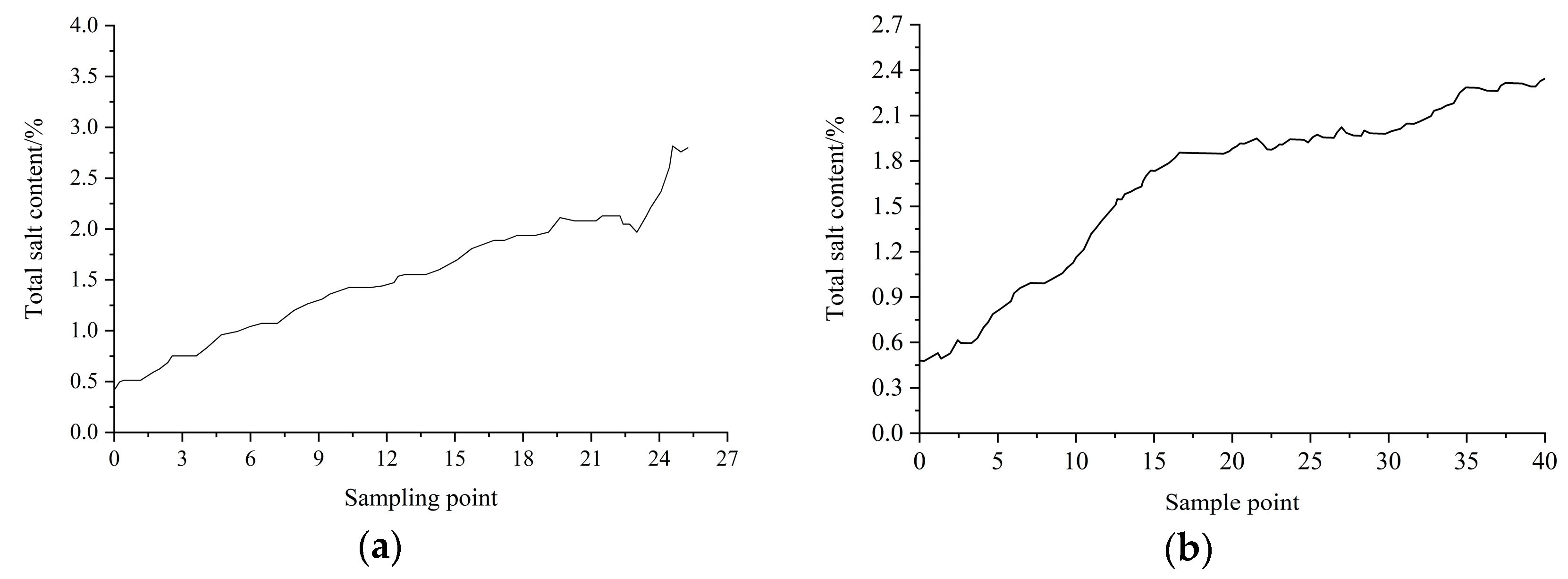
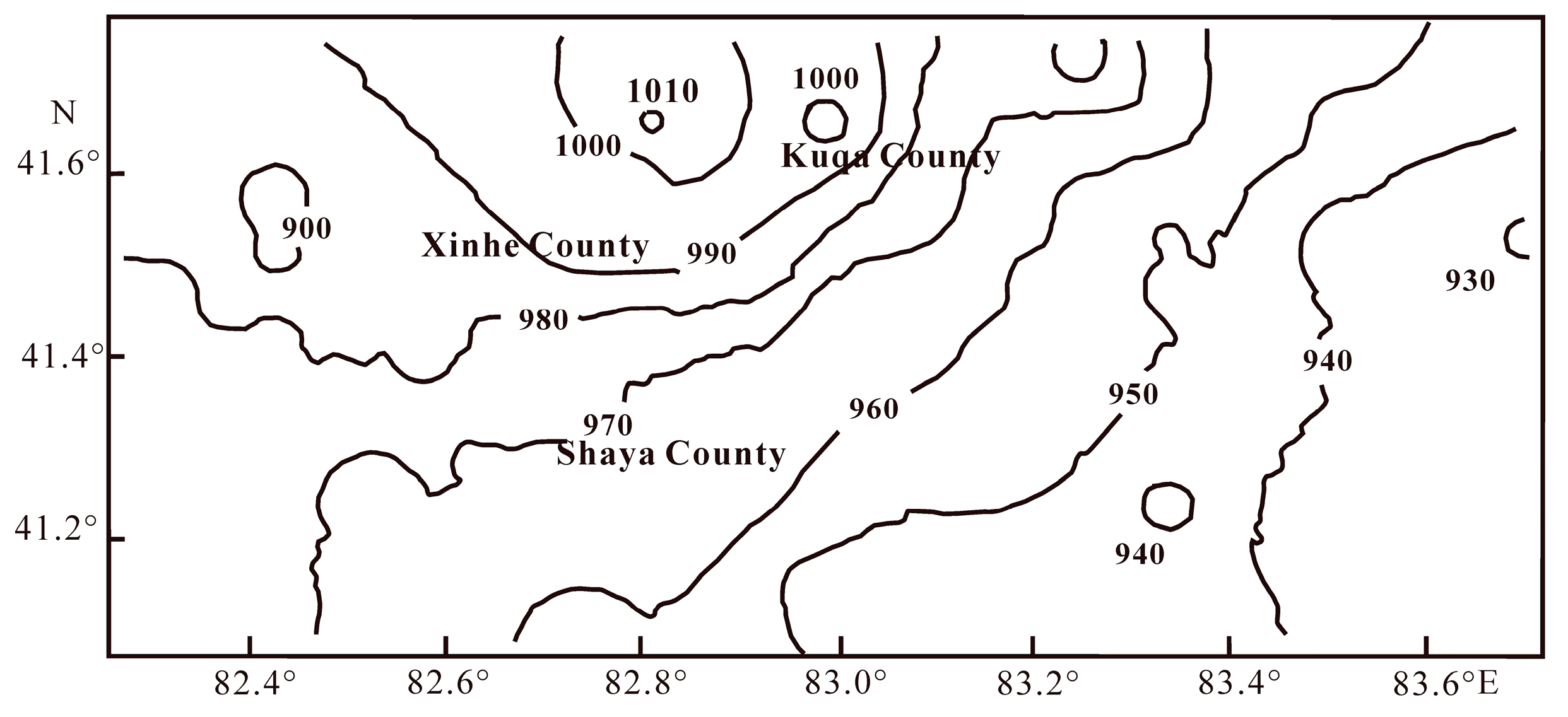
| Depth/m | n | Min | Max | Mean | SD | Skewness | Kurtosis | CV | Converted p-Value |
|---|---|---|---|---|---|---|---|---|---|
| (%) | (%) | (%) | |||||||
| 0–0.25 m | 92 | 0.04 | 10.35 | 1.27 | 1.46 | 2.72 | 7.74 | 1.150 | 0.2 |
| 1–2 m | 92 | 0.01 | 5.64 | 0.87 | 0.89 | 2.56 | 7.23 | 1.023 | 0.2 |
| 2–3 m | 92 | 0.06 | 5.11 | 0.79 | 0.92 | 2.73 | 6.46 | 1.265 | 0.052 |
| Depth/m | 95% Confidence Level | 95% Confidence Level | ||||
|---|---|---|---|---|---|---|
| 5% | 10% | 20% | 5% | 10% | 20% | |
| 0–0.25 | 1422 | 355 | 89 | 866 | 217 | 54 |
| 1–2 | 1126 | 281 | 70 | 686 | 171 | 43 |
| 2–3 | 1459 | 365 | 91 | 889 | 222 | 56 |
| Depth/m | Model | Nugget C0 | Sill C0 + C | Range a/km | Nugget Coefficients C0/(C0 + C) | R2 | RSS |
|---|---|---|---|---|---|---|---|
| 0–0.25 | Spherical | 1.459 | 2.086 | 56.0 | 69.5 | 0.756 | 0.108 |
| 1–2 | Spherical | 0.010 | 1.216 | 18.2 | 0.8 | 0.830 | 0.042 |
| 2–3 | Exponential | 0.139 | 1.309 | 24.9 | 10.2 | 0.761 | 0.129 |
| Depth/m | Major Axis Direction Angle/° | Major Axis Range a/km | Minor Axis Range a/km | Anisotropy Ratio/k | Nugget C0 | Sill C0 + C |
|---|---|---|---|---|---|---|
| 0–0.25 m | 133 | 75.39 | 44.66 | 1.69 | 1.416 | 2.002 |
| 43 | 44.66 | 75.39 | 0.59 | 1.416 | 2.002 | |
| 1–2 m | 120 | 44.36 | 15.58 | 2.84 | 0.02 | 1.227 |
| 30 | 15.58 | 44.36 | 0.35 | 0.02 | 1.227 | |
| 2–3 m | 124 | 76.56 | 25.08 | 3.05 | 0.127 | 1.354 |
| 34 | 25.08 | 76.56 | 0.32 | 0.127 | 1.354 |
| Interpolation Method | I Value | |
|---|---|---|
| Ordinary Kriging | 2.625 | 2.725 |
| Nested model method | 1.588 | 1.636 |
Publisher’s Note: MDPI stays neutral with regard to jurisdictional claims in published maps and institutional affiliations. |
© 2022 by the authors. Licensee MDPI, Basel, Switzerland. This article is an open access article distributed under the terms and conditions of the Creative Commons Attribution (CC BY) license (https://creativecommons.org/licenses/by/4.0/).
Share and Cite
Lu, L.; Li, S.; Gao, Y.; Ge, Y.; Zhang, Y. Analysis of the Characteristics and Cause Analysis of Soil Salt Space Based on the Basin Scale. Appl. Sci. 2022, 12, 9022. https://doi.org/10.3390/app12189022
Lu L, Li S, Gao Y, Ge Y, Zhang Y. Analysis of the Characteristics and Cause Analysis of Soil Salt Space Based on the Basin Scale. Applied Sciences. 2022; 12(18):9022. https://doi.org/10.3390/app12189022
Chicago/Turabian StyleLu, Li, Sheng Li, Yuan Gao, Yanyan Ge, and Yun Zhang. 2022. "Analysis of the Characteristics and Cause Analysis of Soil Salt Space Based on the Basin Scale" Applied Sciences 12, no. 18: 9022. https://doi.org/10.3390/app12189022
APA StyleLu, L., Li, S., Gao, Y., Ge, Y., & Zhang, Y. (2022). Analysis of the Characteristics and Cause Analysis of Soil Salt Space Based on the Basin Scale. Applied Sciences, 12(18), 9022. https://doi.org/10.3390/app12189022




